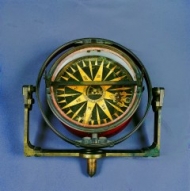
In our store customers can find a wide range of compasses of different sizes and age.
In our shop we showcase the evolution of compass, from the most ancient with paper rose, to more recent liquid compasses.
Our collection is continually updated, please write back for any request.
The Compass
The earth magnetic field was most likely first used for orientation purposes by the Chinese, while it was ignored by the Greeks and the Romans. The Greeks and the Romans only knew one of the properties of magnets, namely the property of attracting iron, while they did not notice the constant orientation of a small, freely swinging element. According to more convincing sources, this property was discovered by the Chinese, who apparently made use of a magnetized needle for land communication around 1000 years ago. For sea communication, they used a magnetized needle on a piece of cork, free to float in a small water bowl. Evidence shows that it was the Arabs who provided a link between the East and the West. This archaic compass came to be used in the Mediterranean Sea between the 11th and the 12th century, while the modern compass appeared in the following century. At the beginning of the 14th century, sailors from Amalfi (Italy) perfected the instrument by fastening the needle to the centre of a wood disk while applying a compass rose to the rotating needle. They also divided the rose into quadrants (11°-15’) according to the directions of the main winds: north wind, north-east wind, south-east wind. In the earlier times, roses were hand drawn and painted by artists, but later on they started to be printed on thin copper foils due to the scarce precision of hand drawing. The Amalfi people were the first to represent the north with a lily, which was the emblem of the Angiò family, while in France the north was always marked with a fleur-de-lys. This was the most popular kind of nautical compass in the 19th century. The gimbal was applied to the compass in the 16th century and was probably built by the mechanic Janello Torriani, who introduced it in the Spanish Navy where he worked for Charles V. The wood disk to which the paper-painted - and later printed - wind rose was attached, was soon replaced by a rigid mica one, although new lighter materials were being sought. The so called multiple needles or Thomson Rose was thus created (1876) and weighed only a few grams. |

William Thomson (1824-1907) modified the nautical compass by making the moving parts lighter in order to avoid oscillations; to this purpose he also shortened the needles in order to correct quadrants errors and other kinds of errors arising from magnetic deviation due to the increasing use of iron in the construction of hulls. The Kelvin Compass received the patent in 1876, and was named after the title that Mr. Thomson acquired after becoming Baron Lord Kelvin of Largs in 1892. This compass consisted of a hard stone cap set on a brass ring with thin and strong silk threads holding a rose printed on silk paper and attached to aluminium rings. Underneath, a magnetic device consisting of 6 to 8 stainless steel needles divided into two parallel groups, was held by these same threads. This type of dry compass could not be improved any further; the only way to increase the directional power of the rose, was by increasing its size and the weight of the needles accordingly. At some point, in order to compensate such a weight which increased friction, a float was fitted around the cap and the whole device was placed in a supporting liquid. This meant a return to the origins of the nautical compass consisting of a needle placed on a straw floating on water. The first liquid compass dates back to 1813 although it would only be adopted by the end of the 19th century. The liquid is generally water and alcohol or water and glycerine, both mixed with antifreeze agents. It included 8 or more thin and light magnetized needles tied to the wind rose with a system of strings. On both sides of the compass binnacle there were two soft iron spheres with two correction magnets placed underneath to reduce the effects of the iron hull. |

Aboard big ships there are several compasses according to their function.
Steering Compass
This compass is used by the helmsman to stay on course, and it’s placed forward of the helm dashboard lengthwise of the ship.
Survey Compass
It is provided with eye vanes and object vanes, which are set up in such a way that either earth or celestial bodies can be observed through mirrors and prisms. This compass is placed on an open space or in any place with maximum visibility.
Surveyor's compass
It is used to control the binnacle.
Reversed compass
Reversed suspension compass which is usually found in the captain’s deck. It is used to control that orders given to helmsmen are carried out correctly without leaving the position.
Mining Compasses “Nancy Compasses”
Also mining compasses called “Nancy compasses” are beautiful and worth mentioning. They consist of a wood box with a flat base on which brass mounts are still visible, which should host a bottom joint to be fastened to a tripod. The upper surface houses a big compass with flower ornaments printed on the wind rose, pointing to the 8 cardinal points. N-NE-E-SE-S- SW-W-NW; Double angle division respectively one on the paper edge from 0° to 90° to 0°, and one in the silver goniometric ring from 0° to 180° to 0° to 180°; the needle is free to rotate on the pivot through a side lock, which is activated by a screw lock; a spirit level on the side of the compass, near a double wood dioptre allows to point positions that require measurement. A sliding shutter protects the instrument during transport.
|